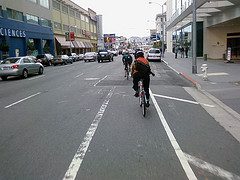In a fascinating post over at Next American City, Dave Steele observes a big divide among bike commuters: the affluent, geared-up, environmentalist, health-conscious cyclists by choice, and those who are commuting by bike because they can’t afford other means:
“For a lot of people, biking is a neccessity. Rather than a source of pride, riding is often a source of shame, a visible symbol of poverty.
“I encounter many of these Unseen Bicyclists in my daily travels. Usually riding without a helmet or other safety gear, these cyclists keep their heads down and go about their business, riding to work and other places where the bus routes don’t go. I often see them engaging in dangerous practices, such as riding on the sidewalk or against traffic. Their bikes are often in poor condition, with squeaky wheels and gears. With major cutbacks in transit service in recent years, and a huge increase in bus fares (and the price of gasoline), I’ve been seeing more and more of my fellow citizens biking out of neccessity.
“The urban poor and working class take work when and where they can get it, which often means third or second shift and far from home, out of reach of public transit. Long bike commutes in the dark, without safety gear, lead to a high rate of injuries and fatalities among low-income bikers in many cities.”
As soon as I read it, I knew who he was talking about. When you first say “bikes” and the urban poor, I think the image that flashes into many minds (certainly those of many of my on-edge neighbors) is groups of teenagers cruising the streets, sometimes two to a bike, often careering in and out of traffic and giving drivers heart attacks.
But I know the other group Steele means. The adults, quiet and serious, sometimes with precarious loads, often tired looking, heading where they need to go.
What does it mean about class gaps and attitudes that I have never once heard of (nor thought of, to be honest, before now, despite being a cyclist) including bicycles in journey-to-work or transportation access programs? (This detailed report mentions the word “bicycle” only twice — once negatively, as something to be overcome.)
Why do we work on fixing up old bikes for low-income kids, but never consider helping the working poor or people trying to transition off public assistance get a functional, safe bike, with a helmet, headlights, and a child seat? Surely it wouldn’t help in all cases, but I know of plenty of employment centers around here that could be theoretically bikeable from downtown.
Such assistance would not only be cheaper to do up front, but a lot more sustainable for the recipient to maintain than the donate-a-car type movements.
Of course on the activism side, this would mean more focus on bikes in transportation justice organizing, and more focus on the bike accessibility of low-wage job centers for bike activists and planners.
The rub may be the gap in attitudes. Can those forced to bike commute come to embrace it and fight for safe bikeways? Can the cyclists by choice interact with cyclists by necessity and not start off scolding them about needing a helmet and following traffic rules?
(photo by luxomedia, Creative Commons by-nc-sa license 2008)






Amen. It is indeed curious that these fix-a-bike programs are geared so much toward children. I suppose if you get kids to see biking and bike education as cool when they’re young, it’d be more likely to stick when they’re teens and adults. But it seems to me the big challenge is the lack of infrastructure for all would-be bike commuters, whether they ride $10,000 bikes or beat-up Schwinns from 25 years ago, is the lack of infrastructure to help them get where they are going. That’s the bike lanes, the places to lock bikes and showers at work, etc. I would guess the last two are issues for anybody, certainly anyone working in an office setting.
You seem to segregate your types of cyclists much more than necessary. While many of the people I know don’t strictly speaking have to bike – they could buy a car – they couldn’t buy and operate a car and maintain their otherwise middle class lifestyles. Likewise, despite already owning a car, I couldn’t pay for gas and parking daily without a significant decline in lifestyle.
Anyway, I do find it odd that you haven’t considered this. I’m involved with a local bike club, and a lot of what we do – aside from providing shop space and tools to anyone who’s interested – is put together and maintain bikes for people who can’t afford to buy one or pay professional mechanics.
Neil,
You’re right. Like so many things, its more of a continuum than two discrete groups. My family actually falls into the group you’re describing, much like you.
I think I was more concerned with the cultural gap—you and I seem to see our cycling as empowerment still, a way to improve our finances and lifestyles, and we are more likely to join a bike club, etc. I think the post I was linking to was arguing that there is a group that feels their reliance on bikes is shameful and is not likely to advocate for their needs as cyclists as a result.
I was adding that social service agencies are also not likely to focus on it as a viable alternative.
But you’re right—underneath there is much common ground, and that’s why it would be worth finding a way to bridge the gap.